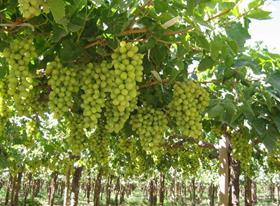
The first-ever shipment of Chilean table grapes to Australia is on its way, but the news of the pending arrival has sparked a spat between industry officials from the two countries.
A sea container from Chile comprising 5,500 cartons of white seedless grapes is already on the water to Australia, according to Jeff Scott, CEO of the Australian Table Grape Association, who told local media that a further shipment by air could well arrive in the next week.
Australia gave the green light for Chilean table grape imports five years ago subject to a stringent protocol that requires pre-clearance by an Australian Quarantine and Inspection Service (AQIS) inspector as well as fumigation with methyl bromide. But this is the first time that the protocol has been tested, and, according to Mr Scott, it is bad timing for the Australian table grape industry, whose season is in full flow.
“We have a total oversupply of table grapes in Australia `at the moment`,” Mr Scott told ABC Rural. “We don’t get upset when we have imports coming in from America, or possibly this year from China, because they are counterseasonal. Whereas in this case with Chile, they’re actually bringing in grapes when we have an oversupply and they’re competing directly with Australia.”
Mr Scott told the Weekly Times that the Australian Table Grape Association was launching a promotional push with domestic consumers to educate them about the continued availability of Australian grapes and to urge them to look for country-of-origin labelling. He added that the campaign would highlight that Chilean grapes had been fumigated with methyl bromide, sulphur dioxide and carbon dioxide gasses that would affect quality and shelf life.
Mr Scott reportedly slammed the move to bring in foreign produce during the domestic season as “despicable” and “irresponsible”, and his remarks have drawn an angry response from Fedefruta, Chile’s peak fruit and vegetable grower body.
Fedefruta president Antonio Walker told freshfruitportal.com that Mr Scott’s comments reflected a protectionist viewpoint.
“If you want protection from imports and from the rest of the world, it would be consistent that you agree not to export,” said Mr Walker, imploring Mr Scott to see the advantages of competition. “When competition arrives one is obliged to improve quality and performance, and reduce costs, among other things. We are in a globalised world of free trade and must be willing to get competition.”
Mr Walker also branded Mr Scott’s move to highlight the methyl bromide-treatment of Chilean grapes as reason not to consume them as a “cheap excuse”.
Fedefruta director Rodrigo Echeverria told freshfruitportal.com that Australia quarantine authorities demanded the used of methyl bromide to meet SPS standards, highlighting that Chile did not use the compound voluntarily. “I believe it is a misguided strategy that Australian leaders have taken,” he said.
Australia has been enduring a particularly challenging table grape season, marked by rain-induced quality issues, fruit fly outbreaks and a high-flying dollar, which have combined to cut exports and place increased pressure on the domestic market. That strong dollar, however, favours importing fruits, although the move to bring in Chilean table grapes while Australian grapes still fill shelves has puzzled others in the industry besides the Australian Table Grape Association.
The company importing the Chilean grapes and the destination will not be known until the product arrives, but Tuong Luu of Luu Global, a specialist in table grape exports from Australia and other countries, said that flying Chilean grapes into Australia right now was a “high-risk” move.
“The cost of airfreighting the fruit is likely to be more than double that of the fruit itself and by the time you have added in all the other costs of bringing the product to market, you need to be getting around A$45 per carton to make it worthwhile, but we’ve still got Australian green grapes selling for A$22-25 per carton in the market now. If there are no green grapes in the market, it may work, but it’s very high risk.”
While supplies of red grapes remain plentiful in Australia, Mr Luu said the white seedless season is reaching its end. Although this signals a potential window of opportunity for imported white seedless grapes, whether it is workable for Chile remains questionable.
“Shipping by sea may work from a cost and price point of view,” said Mr Luu, although he cautioned that arrival quality could be an issue.
Methyl bromide fumigation is known to affect the quality and shelf life of grapes, so shipping by sea is fraught with risk, particularly with white seedless grapes that show the effects more than red grapes.
“I think the importer is just doing this as a trial at this stage to see how the fruit outturns,” said Mr Luu.
An AQIS inspector has reportedly been stationed in Chile’s capital Santiago since 28 March and two containers of Chilean grapes have so far been cleared for shipment.



